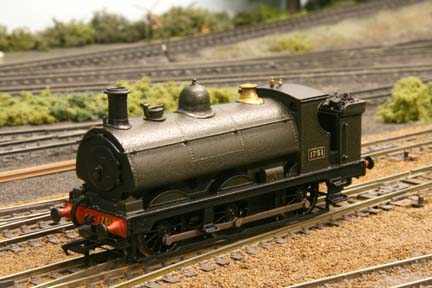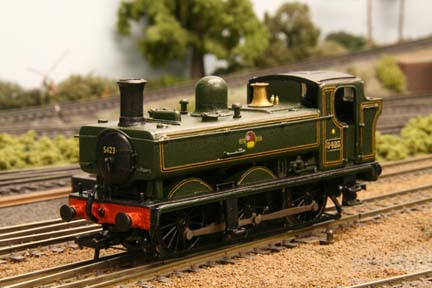GWR and BR(WR) Models 10
 In the 20th century, the Great Western
Railway was famous for its pannier tanks, but in late Victorian times, the
GWR built over a thousand saddle tanks, of various classes, like the one
above, a member of the 1854 or 1701 class (don't ask!). Because of the GWR's
policy of evolution of its designs, with upgrades along the way, these saddle
tanks, although belonging to different classes, were very similar in appearance.
Most were rebuilt eventually with panniers, because saddle tanks were not
suitable for the new Belpaire fireboxes, which became the standard for GWR
locos. No.1751 was actually one of the last 1854 class locos to be rebuilt
in the early 1930s. It is seen here in the pre-1928 shade of Great Western
green.
This loco was built using a South Eastern
Finecast kit - this manufacturer also makes the pannier tank version. These
kits are very versatile, and due to the family appearance of these locos,
as the kit instructions state, other classes can be made, with on occasions,
only quite minor modifications - the 2721 class for example is almost identical
(they too started life as saddle tanks) but had fluted coupling rods.
This is the first loco I have built that
is destined for my new 1920s era Great Western branchline layout, which
is still in the planning stage at the moment. Watch these pages for more
developments.
In the 20th century, the Great Western
Railway was famous for its pannier tanks, but in late Victorian times, the
GWR built over a thousand saddle tanks, of various classes, like the one
above, a member of the 1854 or 1701 class (don't ask!). Because of the GWR's
policy of evolution of its designs, with upgrades along the way, these saddle
tanks, although belonging to different classes, were very similar in appearance.
Most were rebuilt eventually with panniers, because saddle tanks were not
suitable for the new Belpaire fireboxes, which became the standard for GWR
locos. No.1751 was actually one of the last 1854 class locos to be rebuilt
in the early 1930s. It is seen here in the pre-1928 shade of Great Western
green.
This loco was built using a South Eastern
Finecast kit - this manufacturer also makes the pannier tank version. These
kits are very versatile, and due to the family appearance of these locos,
as the kit instructions state, other classes can be made, with on occasions,
only quite minor modifications - the 2721 class for example is almost identical
(they too started life as saddle tanks) but had fluted coupling rods.
This is the first loco I have built that
is destined for my new 1920s era Great Western branchline layout, which
is still in the planning stage at the moment. Watch these pages for more
developments.
.jpg) This lovely looking loco is another of
the 'Duke of Cornwall' or just 'Duke' class. No.3253 "Pendennis Castle"
features the early style of straight nameplates affixed to the side of the
boiler. Built from a Nu-Cast kit.
This lovely looking loco is another of
the 'Duke of Cornwall' or just 'Duke' class. No.3253 "Pendennis Castle"
features the early style of straight nameplates affixed to the side of the
boiler. Built from a Nu-Cast kit.
 No.602 is a former Taff Vale Railway U1
class 0-6-2T. Built from a South Eastern Finecast kit, it would make an
interesting variation to any GWR loco stud.
No.602 is a former Taff Vale Railway U1
class 0-6-2T. Built from a South Eastern Finecast kit, it would make an
interesting variation to any GWR loco stud.
 Just another GWR pannier tank? Not quite.
This is a member of the 54xx class, built for auto train working, where
the little 48xx (or 14xx in later years) were not powerful enough. These
locos had 5'2" coupled wheels (like the 48xx/14xx locos), which can
clearly be distinguished by the larger splashers. In Collett's time, most
pannier tanks had driving wheels of 4' 7 1/2", so these little locos
had a greater turn of speed. Built from a Nu-Cast kit, she is seen wearing
the post-1956 full passenger lined green livery, which was bestowed upon
almost any Western loco likely to work passenger trains at the time.
Just another GWR pannier tank? Not quite.
This is a member of the 54xx class, built for auto train working, where
the little 48xx (or 14xx in later years) were not powerful enough. These
locos had 5'2" coupled wheels (like the 48xx/14xx locos), which can
clearly be distinguished by the larger splashers. In Collett's time, most
pannier tanks had driving wheels of 4' 7 1/2", so these little locos
had a greater turn of speed. Built from a Nu-Cast kit, she is seen wearing
the post-1956 full passenger lined green livery, which was bestowed upon
almost any Western loco likely to work passenger trains at the time.
 A classic amongst British railway locomotive
designs - the Collett Goods, or 2251 class. This model features the doyen
of the class, together with its Churchward 3,000 gallon tender, which the
first batch built were paired with. Built from a South Eastern Finecast
kit.
A classic amongst British railway locomotive
designs - the Collett Goods, or 2251 class. This model features the doyen
of the class, together with its Churchward 3,000 gallon tender, which the
first batch built were paired with. Built from a South Eastern Finecast
kit.
 Another outside-framed Dean Goods (2361
class) - this time in the pre-1906 indian red-framed livery.
Back to page 9
Return to home page
Go to page 11
Another outside-framed Dean Goods (2361
class) - this time in the pre-1906 indian red-framed livery.
Back to page 9
Return to home page
Go to page 11


.jpg)



